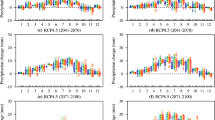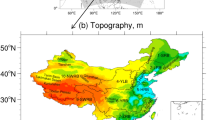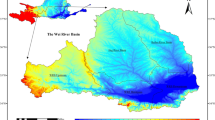Abstract
Four bias correction methods, i.e., gamma cumulative distribution function (GamCDF), quantile–quantile adjustment (QQadj), equidistant cumulative probability distribution function (CDF) matching (EDCDF), and transform CDF (CDF-t), to read are applied to five daily precipitation datasets over China produced by LMDZ4-regional that was nested into five global climate models (GCMs), BCC-CSM1-1m, CNRM-CM5, FGOALS-g2, IPSL-CM5A-MR, and MPI-ESM-MR, respectively. A unified mathematical framework can be used to define the four bias correction methods, which helps understanding their natures and essences for identifying the most reliable probability distributions of projected climate. CDF-t is shown to be the best bias correction method based on a comprehensive evaluation of different precipitation indices. Future precipitation projections corresponding to the global warming levels of 1.5 °C and 2 °C under RCP8.5 were obtained using the bias correction methods. The multi-method and multi-model ensemble characteristics allow to explore the spreading of projections, considered a surrogate of climate projection uncertainty, and to attribute such uncertainties to different sources. It was found that the spread among bias correction methods is smaller than that among dynamical downscaling simulations. The four bias correction methods, with CDF-t at the top, all reduce the spread among the downscaled results. Future projection using CDF-t is thus considered having higher credibility.







Similar content being viewed by others
Data availability
The interpolated 0.5° × 0.5° daily precipitation datasets are available from the URL (http://rcg.gvc.gu.se/). The LMDZ4 datasets are available from the NEC-SX5 of the IDRIS/CNRS computer center.
References
Amengual A, Homar V, Romero R et al (2012) A statistical adjustment of regional climate model outputs to local scales: application to Platja de Palma, Spain. J Clim 25(3):939–957. https://doi.org/10.1175/JCLI-D-10-05024.1
Chen HP, Sun JQ (2018) Projected changes in climate extremes in China in a 1.5°C warmer world. International Journal of Climatology. https://doi.org/10.1002/joc.5521
Chen D, Ou T, Gong L et al (2010) Spatial interpolation of daily precipitation in China: 1951-2005. Adv Atmos Sci 27(6):1221–1232. https://doi.org/10.1007/s00376-010-9151-y
Chen WL, Jiang ZH, Li L, Yiou P (2011) Simulation of regional climate change under the IPCC A2 scenario in Southeast China. Clim Dyn 36:491–507. https://doi.org/10.1007/s00382-010-0910-3
Chen J, Brissette FP, Chaumont D, Braun M (2013) Performance and uncertainty evaluation of empirical downscaling methods in quantifying the climate change impacts on hydrology over two North American river basins. J Hydrol. https://doi.org/10.1016/j.jhydrol.2012.11.062
Dosio A (2016) Projections of climate change indices of temperature and precipitation from an ensemble of bias-adjusted high-resolution EURO-CORDEX regional climate models. Journal of Geophysical Research: Atmospheres 121:5488–5511. https://doi.org/10.1002/2015JD024411
Dosio A, Paruolo P (2011) Bias correction of the ENSEMBLES high-resolution climate change projections for use by impact models: evaluation on the present climate. J Geophys Res 116(117):127–135. https://doi.org/10.1029/2011JD015934
Dufresne JL, Foujols MA, Denvil S et al (2013) Climate change projections using the IPSL-CM5 Earth System Model: from CMIP3 to CMIP5. Clim Dyn 40(9–10):2123–2165. https://doi.org/10.1007/s00382-012-1636-1
Fatichi S, Ivanov VY, Paschalis A, Peleg N et al (2016) Uncertainty partition challenges the predictability of vital details of climate change. Earth’s Future 4:240–251. https://doi.org/10.1002/2015EF000336
Guo LY, Gao Q, Jiang ZH, Li L (2018) Bias correction and projection of surface air temperature in LMDZ multiple simulation over central and eastern China. Adv Clim Chang Res 9(1):81–92. https://doi.org/10.1016/j.accre.2018.02.003
Haddad ZS, Rosenfeld D (1997) Optimality of empirical Z-R relations.Q J R Meteorol Soc 123(541):1283–1293. https://doi.org/10.1002/qj.49712354107
Haylock MR, Cawley GC, Harpham C, Wilby RL, Goodess CM (2006) Downscaling heavy precipitation over the United Kingdom: a comparison of dynamical and statistical methods and their future scenarios. Int J Climatol 26(10):1397–1415. https://doi.org/10.1002/joc.1318
Her Y, Yoo SH, Cho J et al (2019) Uncertainty in hydrological analysis of climate change: multi-parameter vs. multi-GCM ensemble predictions. Scientific Reports 9:4974. https://doi.org/10.1038/s41598-019-41334-7
Hourdin F, Musat I, Bony S et al (2006) The LMDZ4 general circulation model: climate performance and sensitivity to parametrized physics with emphasis on tropical convection. Clim Dyn 27(7–8):787–813. https://doi.org/10.1007/s00382-006-0158-0
Hu T, Sun Y, Zhang XB (2017) Temperature and precipitation projection at 1.5°C and 2°C increase in global mean temperature. Chinses Science Bulletin. https://doi.org/10.1360/N972016-01234
King AD, Karoly DJ, Henley BJ (2017) Australian climate extremes at 1.5 °C and 2 °C of global warming. Nat Clim Chang 7:412–416. https://doi.org/10.1038/nclimate3296
Knutti R, Sedlacek J (2013) Robustness and uncertainties in the new CMIP5 climate model projections. Nat Clim Chang 3:369–373. https://doi.org/10.1038/nclimate1716
Knutti R, Rogelj J, Sedlacek J, Fischer EM (2016) A scientific critique of the two-degree climate change target. Nat Geosci 9(1):13–18. https://doi.org/10.1038/NGEO2595
Lafon T, Dadson S, Buys G, Prudhomme C (2013) Bias correction of daily precipitation simulated by a regional climate model: a comparison of methods. Int J Climatol 33:1367–1381. https://doi.org/10.1002/joc.3518
Lavaysse C, Vrac M, Drobinski P, Lengaigne M, Vischel T (2012) Statistical downscaling of the French Mediterranean climate: assessment for present and projection in an anthropogenic scenario, Natural Hazards and Earth System. Sciences 12:651–670. https://doi.org/10.5194/nhess-12-651-2012
Li ZX (1999) Ensemble atmospheric GCM simulation of climate interannual variability from 1979 to 1994. J Clim 12:986–1001. https://doi.org/10.1175/1520-0442(1999)012<0986:EAGSOC>2.0.CO;2
Li H, Sheffield J, Wood EF (2010) Bias correction of monthly precipitation and temperature fields from Intergovernmental Panel on Climate Change AR4 models using equidistant quantile matching. Journal of Geophysical Research Atmospheres 115(D10). https://doi.org/10.1029/2009JD012882
Li W, Jiang ZH, Zhang XB, Li L, Sun Y (2018) Additional risk in extreme precipitation in China from 1.5°C to 2.0°C global warming levels. Science Bulletin 63(4). https://doi.org/10.1016/j.scib.2017.12.021
Maraun D, Widmann M (2018) Cross-validation of bias-corrected climate simulations is misleading. Hydrol Earth Syst Sci 22:4867–4873. https://doi.org/10.5194/hess-22-4867-2018
Maraun D, Widmann M, Gutiérrez José M et al (2015) VALUE: A framework to validate downscaling approaches for climate change studies. Earths Future 3(1):1–14. https://doi.org/10.1002/2014EF000259
Michelangeli PA, Vrac M, Loukos H (2009) Probabilistic downscaling approaches: application to wind cumulative distribution functions. Geophys Res Lett 36:L11708. https://doi.org/10.1029/2009GL038401
Panofsky HA, Brier GW, Best WH (1958) Some application of statistics to meteorology. Penn State University Tech. Rep. 24pp
Perkins SE, Pitman AJ, Holbrook NJ, Mcaneney J (2007) Evaluation of the AR4 climate models’ simulated daily maximum temperature, minimum temperature, and precipitation over Australia using probability density functions. J Clim 20:4356–4376. https://doi.org/10.1175/JCLI4253.1
Schaeffer M, Hare W, Rahmstorf S, Vermeer M (2012) Long-term sea-level rise implied by 1.5°C and 2°C warming levels. Nat Clim Chang 2:867–870. https://doi.org/10.1038/nclimate1584
Seneviratne SI, Nicholls N (2012) Changes in climate extremes and their impacts on the natural physical environment. In Managing the risks of extreme events and disasters to advance climate change adaptation: a special report of working groups I and II of the Intergovernmental Panel on Climate Change (IPCC). Cambridge University Press: Cambridge
Sharma D, Das GA, Babel MS (2007) Spatial disaggregation of bias-corrected GCM precipitation for improved hydrologic simulation: Ping River Basin, Thailand. Hydrol Earth Syst Sci 11:1373–1390. https://doi.org/10.5194/hessd-4-35-2007
Shi C, Jiang ZH, Chen WL, Li L (2018) Changes in temperature extremes over China under 1.5°C and 2°C global warming targets. Advances in Climate Change Research. https://doi.org/10.1016/j.accre.2017.11.003
Sun F, Roderick ML, Lim WH, Farquhar GD (2011) Hydroclimatic projections for the Murray-Darling Basin based on an ensemble derived from Intergovernmental Panel on Climate Change AR4 climate models. Water Resources Research 47:W00G02. https://doi.org/10.1029/2010WR009829
Taylor KE (2001) Summarizing multiple aspects of model performance in a single diagram. J Geophys Res 106(D7):7183–7192. https://doi.org/10.1029/2000JD900719
Tramblay Y, Ruelland D, Somot S et al (2013) High-resolution Med-CORDEX regional climate model simulations for hydrological impact studies: a first evaluation of the ALADIN-Climate model in Morocco. Hydrology & Earth System Sciences 17(10):3721–3739. https://doi.org/10.5194/hess-17-3721-2013
UNFCC, 2015. Report No. FCCC/CP/2015/L.9/Rev.1. http://unfccc.int/resource/docs/2015/cop21/eng/l09r01.pdf
Vrac M, Drobinski P, Merlo A et al (2012) Dynamical and statistical downscaling of the French Mediterranean climate: uncertainty assessment. Natural Hazards and Earth System Science 12(9):2769–2784. https://doi.org/10.5194/nhess-12-2769-2012
Wang T, Miao JP, Sun JQ, Fu YH (2018) Intensified East Asian summer monsoon and associated precipitation mode shift under the 1.5°C global warming target. Advances in Climate Change Research. https://doi.org/10.1016/j.accre.2017.12.002
Wood A, Leung LR, Sridhar V, Lettenmaier DP (2004) Hydrologic implications of dynamical and statistical approaches to downscaling climate outputs. Clim Chang 62:189–216. https://doi.org/10.1023/b:clim.0000013685.99609.9e
Yang H, Jiang ZH, Li L (2016) Biases and improvements in three dynamical downscaling climate simulations over China. Clim Dyn 47(9–10):3235–3251. https://doi.org/10.1007/s00382-016-3023-9
Yang H, Jiang ZH, Li L, Wang XF, Cui CG (2017) Applicability of a quantile-quantile (Q-Q) bias-correction method for climate dynamical downscaling at Beijing station. Acta Meteorologica Sinica 75(3):460–470
Yang Y, Tang JP, Wang SY, Liu G (2018) Differential impacts of 1.5°C and 2°C warming on extreme events over China using statistically downscaled and bias-corrected CESM low-warming experiment. Geophys Res Lett. https://doi.org/10.1029/2018GL079272
Yu ET, Sun JQ, Chen HP et al (2015) Evaluation of a high-resolution historical simulation over China: climatology and extremes. Clim Dyn 45(7):2013–2031. https://doi.org/10.1007/s00382-014-2452-6
Yu R, Zhai PM, Lu YY (2018) Implications of differential effects between 1.5 and 2∘C global warming on temperature and precipitation extremes in China’s urban agglomerations. Int J Climatol 38:2374–2385. https://doi.org/10.1002/joc.5340
Zhai PM, Yu R, Zhou BQ, Chen Y, Guo JP, Lu YY (2017) Research progress in impact of 1.5°C global and regional scales. Advances in Climate Change Research 13(5):465–472. https://doi.org/10.12006/j.issn.1673-1719.2017.159
Zhang YJ, Fu L, Pan J et al (2017) Projected changes in temperature extremes in China using PRECIS. Atmosphere 8(1):15. https://doi.org/10.3390/atmos8010015
Zhou TJ, Yu RC (2006) Twentieth-century surface air temperature over China and the globe simulated by coupled climate models. J Clim 19:5843–5858. https://doi.org/10.1175/JCLI3952.1
Zhou BT, Wen HQZ, Xu Y, Song LC, Zhang XB (2014) Projected changes in temperature and precipitation extremes in China by the CMIP5 multimodel ensembles. J Clim 27:6591–6611. https://doi.org/10.1175/JCLI-D-13-00761.1
Acknowledgments
We thank the editor and three anonymous reviewers for their constructive comments.
Funding
This study was supported by the National Key Research and Development Program of China (2017YFA0603804, 2018YFC1507704), the Postgraduate Research and Practice Innovation Program of Government of Jiangsu Province (SJKY19_0930), and the Visiting Fellowship from China Scholarship Council (NO. 201908320544). L. Li acknowledges the support of French ANR (Project China-Trend-Stream). D. Chen is supported by the Swedish STINT and MERGE.
Author information
Authors and Affiliations
Corresponding author
Additional information
Publisher’s note
Springer Nature remains neutral with regard to jurisdictional claims in published maps and institutional affiliations.
Electronic supplementary material
ESM 1
(DOCX 5058 kb)
Rights and permissions
About this article
Cite this article
Guo, L., Jiang, Z., Chen, D. et al. Projected precipitation changes over China for global warming levels at 1.5 °C and 2 °C in an ensemble of regional climate simulations: impact of bias correction methods. Climatic Change 162, 623–643 (2020). https://doi.org/10.1007/s10584-020-02841-z
Received:
Accepted:
Published:
Issue Date:
DOI: https://doi.org/10.1007/s10584-020-02841-z




